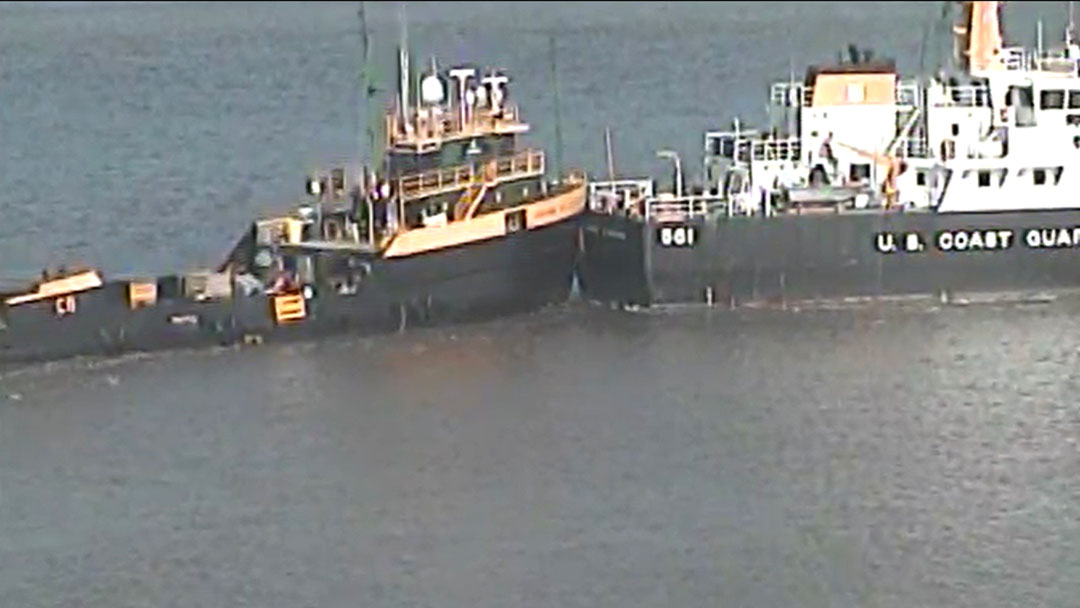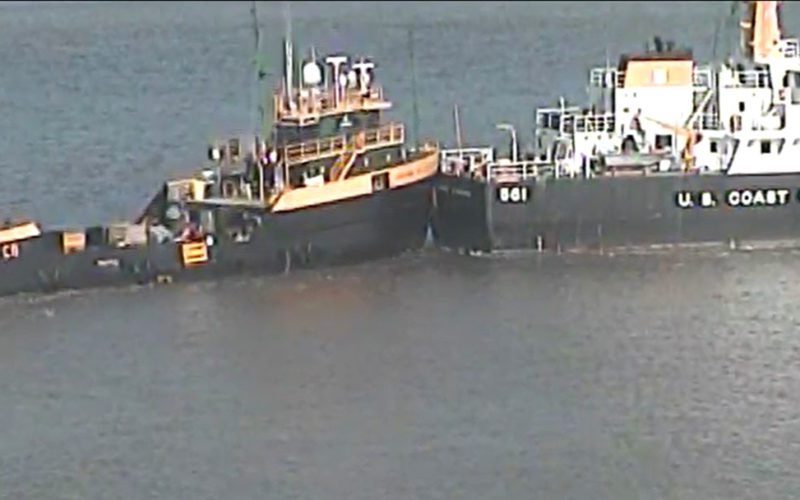
A mistaken assumption about positioning by the captain of an offshore supply vessel (OSV) was the leading factor in a collision with a U.S. Coast Guard cutter in Sabine Pass, according to federal investigators.
Failure by the crew aboard the cutter Harry Claiborne to question the passing arrangement proposed by the captain of Cheramie Bo-Truc No. 33 contributed to the incident, the National Transportation Safety Board (NTSB) said.
The OSV’s bow struck the cutter’s portside transom at 1544 on Oct. 11, 2020. Visibility in the waterway between Texas and Louisiana was 10 nautical miles. Winds were light and seas were calm.
Two days earlier, Hurricane Delta knocked about 30 navigation buoys out of position in Sabine Pass, which divides Texas and Louisiana near the Port of Port Arthur. At the time of the collision, the cutter crew was working at lighted buoy No. 27, which remained in position and marked shallow water at a bend in the waterway.
The OSV captain told investigators he “didn’t realize that the (No. 27) buoy was on location,” and that he “would have never tried to pass on the outside of the buoy.” He chose to pass Harry Claiborne, which was stationary, on the cutter’s starboard side because he thought the buoy had been moved by the storm, the NTSB said.
Investigators concluded that had the captain been monitoring Harry Claiborne and his own vessel’s position on the electronic chart system, he would have seen that the cutter was on the edge of the channel at the buoy’s assigned location.
The Harry Claiborne officer of the deck told investigators that he found the passing arrangement “kind of odd” considering the channel was completely open on the port side of the cutter with no inbound traffic of concern. The cutter crew deferred to the OSV captain because they assumed he had more experience navigating local waters.
But when the captain attempted to pass on the starboard side of the 175-foot cutter, he encountered shallow water that threatened to ground his vessel. The captain decided to steer the 168-foot OSV back to port to clear the cutter, but the maneuver was too late. Realizing a collision was imminent, the captain reversed engines and used the OSV’s bow thruster in an attempt to avoid the impact.
Momentum from the collision carried Cheramie Bo-Truc No. 33 toward shore, where the supply ship grounded with its stern in the mud. The crew freed the vessel within an hour and the captain began maneuvering to port to clear the cutter, which was holding its position using its dynamic positioning system. The ebb current, however, steered the OSV’s starboard bow into the cutter’s starboard quarter.
The NTSB said the cause of the second impact was a lack of coordination and communication between the two vessel operators when the Cheramie Bo-Truc No. 33 crew refloated their vessel. While grounded, the boat’s captain began communicating with Vessel Traffic Service in Port Arthur, Texas, regarding his plan to refloat the OSV, but he did not include the cutter crew in the conversation.
“If the crews had communicated with each other, they might have agreed to wait until the cutter could move on, especially considering the proximity of the Cheramie Bo-Truc No. 33 and the ebb current,” NTSB investigators concluded.
Damage from both collisions totaled $440,879 for the cutter and $65,072 for the OSV. Three crewmembers aboard the cutter sustained minor injuries, the NTSB reported.
The captain of Cheramie Bo-Truc No. 33 testified that Harry Claiborne’s crew gave no indication of a possible problem with shallow water if the OSV passed on the cutter’s starboard side. “So I just assumed (the cutter’s commanding officer) knew what the depth of the water was, and that I was good to pass there,” he said.
Harry Claiborne’s commander told investigators that he underestimated the size of the offshore supply vessel when he gave the OK for it to pass on the starboard side of the cutter. “Based on my visual observation of them during the radio call, I didn’t believe they were a 175-ish-foot vessel,” he testified.
He told investigators that safe navigation in that situation is ultimately the responsibility of the OSV. “I’m not responsible for knowing what depth of water that vessel needs to operate in,” the cutter commander testified.
However, he did acknowledge having some second thoughts about how he handled the situation. “I think if I had to do anything different, I would have said, ‘Hey, it might be safer for you on the two whistle (port side),” he told investigators.
The Coast Guard declined comment on the NTSB report. The operators of Cheramie Bo-Truc No. 33 did not respond to a request for comment.

